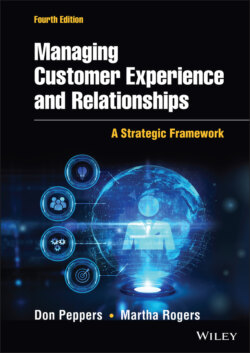Читать книгу Managing Customer Experience and Relationships - Don Peppers - Страница 36
Return on Customer: Measuring and Increasing the Efficiency with Which Customers Create Value
ОглавлениеIf customers are scarce, if they create all the revenue for a company, and if the value they do create is measurable and manageable in the short term and the long term, as of today, then it's natural for companies to want to understand and remember what customers need and to meet those needs better than a competitor that doesn't know the same things about the customers. Customer information provides a very powerful competitive advantage. Companies want to use this information to provide a positive experience for customers and possibly to engage customers in a relationship that enables the company to provide better and better service.33
Most business executives would agree, intellectually, that customers represent the surest route to business growth—getting more customers, keeping them longer, and making them more profitable. Most understand that the customer base itself is a revenue-producing asset for their company—and that the value it throws off ultimately drives the company's economic worth. Nevertheless, when companies measure their financial results, they rarely if ever take into account any changes in the value of this underlying asset, with the result that they are blind—and many financial analysts are blind—to one of the most significant factors driving business success.
Think about your personal investments. Imagine you asked your broker to calculate your return on investment for your portfolio of stocks and bonds. She would tally the dividend and interest payments you received during the year, and then note the increases or decreases in the value of the various stocks and bonds in the portfolio. In other words, she needs to calculate and report both current income plus underlying value changes. The result, when compared to the amount you began the year with, would give you this year's ROI (return on investment). But suppose she chose to ignore any changes in the underlying value of your securities, limiting her analysis solely to dividends and interest. Would you accept this as a legitimate picture of your financial results? No.
Yet this is exactly the way nearly all of today's investors assess the financial performance of the companies they invest in, because this is the only way companies report their results. They count the “dividends” from their customers and ignore any increase (or decrease) in the value of the underlying customer assets. But just as a portfolio of securities is made up of individual stocks and bonds that not only produce dividends and interest but also go up and down in value during the course of the year, a company is, at its roots, a portfolio of customers, who not only buy things from the firm in the current period but also go up and down in value.
Return on investment quantifies how well a firm creates value from a given investment—from the money it uses. But what quantifies how well a company creates value from its customers?34 For this you need the metric of Return on Customer (ROC). The ROC equation has the same form as an ROI equation. ROC equals a firm's current-period cash flow from its customers plus any changes in the underlying customer equity, divided by the total customer equity at the beginning of the period.
Source: Excerpted from Don Peppers and Martha Rogers, Ph.D., Return on Customer (New York: Currency/Doubleday, 2008), pp. 6–7. Return on Customer will be discussed in more detail in Chapter 11.
A customer-strategy enterprise seeks to create one centralized view of each customer across all business units. Every employee who interacts with a customer has to have real-time access to current information about that individual customer so that it is possible to pick up each conversation from where the last one left off. The goal is instant interactivity with the customer. This process can be achieved only through the complete and seamless integration of every enterprise business unit and process.
So far, our discussion of customer relationships, customer experience, and customer value has shown how businesses are undergoing a vast cultural shift—transforming from the mass marketing, product-siloed thinking of the Industrial Age to the customer-empowered culture of the Information Age and the Age of Transparency, where the primary goal is building relationships with individual customers who become measurably more valuable to the enterprise. In this new business era, managing individual customer relationships means an organization will use the knowledge gained from these relationships to improve the quality of the overall customer experience. Consequently, it is incumbent on the enterprise to understand what constitutes a relationship, how relationships are formed, and how they can be strengthened or weakened. Many different perspectives have been developed about what comprises customer relationships and how businesses can profit from them.
By the early 2000s, many companies acknowledged the importance of building relationships with customers—of improving customer experience, taking the customer's point of view, and taking steps to measure and manage customer value. In many cases, companies that had been product-oriented changed their philosophy, their culture, their metrics, and even their organizational structure to put customers at the forefront.
How does a company build a better experience for each customer, keep them longer, get a greater and greater share of their business, and increase their value to the company?
